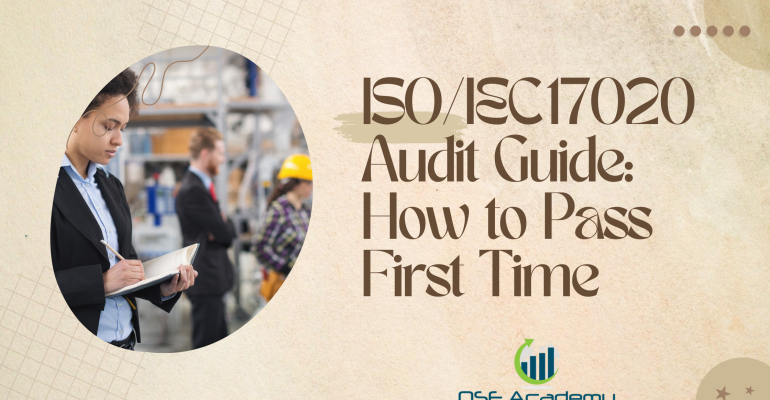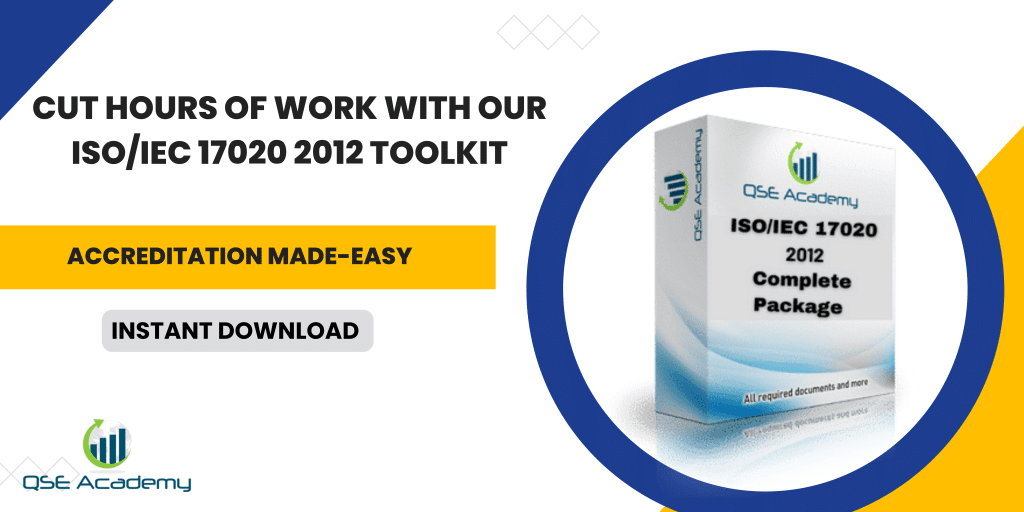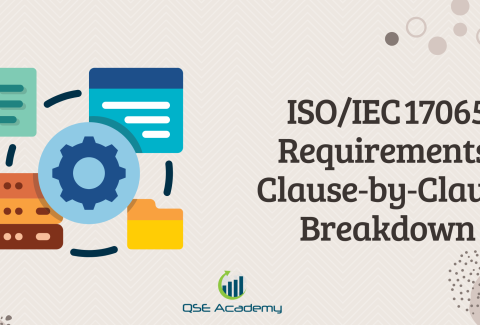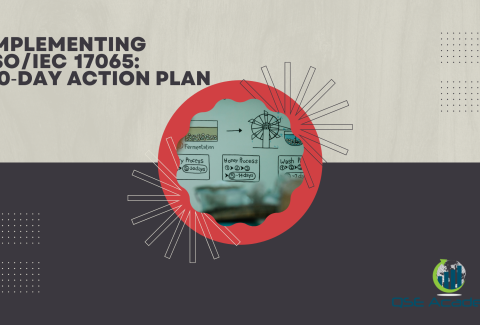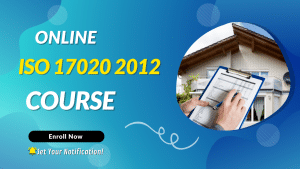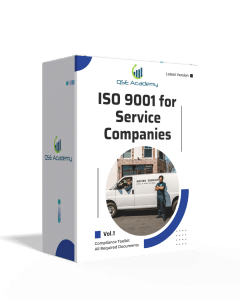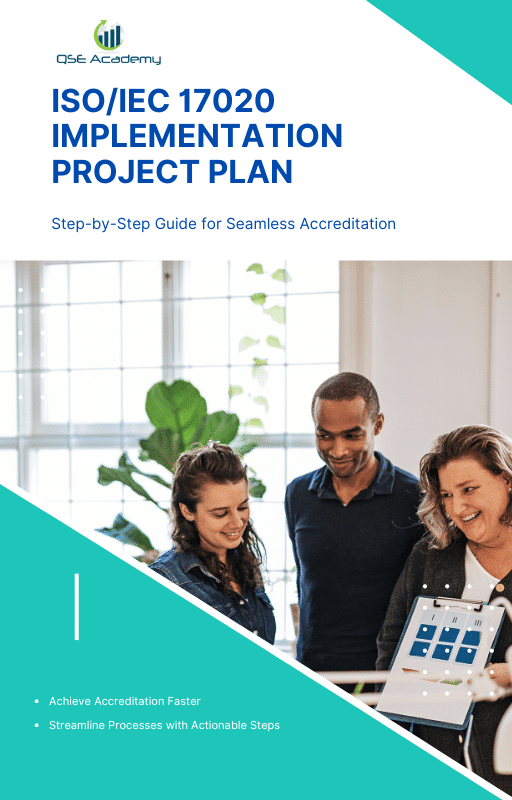ISO/IEC 17020 Audit Guide: How to Pass First Time
Last Updated on October 22, 2025 by Hafsa J.
Why This ISO/IEC 17020 Audit Guide Matters
If you’re preparing for your first ISO/IEC 17020 accreditation audit, this guide is designed to be your complete roadmap. It brings everything you need into one place — every stage, every expectation, and every practical step that helps an inspection body not just survive an audit but pass it confidently the first time.
Audits can feel daunting for a simple reason: they expose how well your system actually works under real-world conditions. Assessors look beyond documents — they want to see proof that your procedures, competence, and impartiality hold up in practice. Passing your first ISO/IEC 17020 audit isn’t about luck; it’s about preparation, understanding what assessors look for, and building a culture of control and consistency long before the audit day arrives.
This pillar guide walks you through the entire process, from early preparation and internal audits to witness assessments and post-audit follow-ups. You’ll learn:
-
How the ISO/IEC 17020 audit process really works — stage by stage.
-
What assessors look for when observing your inspection activities.
-
The most common findings (and how to prevent them).
-
How to respond to non-conformities with solid corrective actions.
-
What habits keep your organization audit-ready all year long.
The goal here isn’t to impress assessors — it’s to build lasting confidence in your inspection system. When your team understands the “why” behind every audit requirement, compliance becomes natural, not stressful.
So, if your goal is to pass your ISO/IEC 17020 audit the first time — and maintain that accreditation with ease in the years ahead — this guide gives you the structure, clarity, and expert insight to get there. Let’s start by breaking down exactly how the ISO/IEC 17020 audit process unfolds.
Understanding the ISO/IEC 17020 Accreditation Audit Process
Before you can pass your ISO/IEC 17020 audit with confidence, you need a clear picture of what the audit process actually looks like. Many inspection bodies assume it’s a single event — one long day with an assessor and a checklist. In reality, accreditation is a multi-stage evaluation that confirms both your system and your competence in performing inspections.
Think of it as a sequence designed to test how well your organization translates documentation into consistent, real-world performance. Each stage builds on the one before it. Here’s how the process typically unfolds:
| Stage | What Happens | Purpose |
|---|---|---|
| 1. Application & Documentation Review | You submit your management system documentation, procedures, and forms for review. | Assessors check that your system aligns with ISO/IEC 17020 requirements before any on-site visit. |
| 2. Office / On-Site Assessment | Assessors visit your office to evaluate implementation — records, training files, impartiality evidence, and calibration control. | To confirm your management system is active, documented, and traceable. |
| 3. Witness Assessment | Assessors accompany your team during a live inspection to observe competence and impartiality in practice. | To verify your technical ability and ensure your system works as written. |
| 4. Corrective Actions & Review | You address any findings raised, submit evidence, and confirm effectiveness. | To demonstrate that your system can identify, correct, and prevent issues. |
| 5. Accreditation Decision | The accreditation body reviews all evidence and reports to make the final decision. | Formal accreditation is granted once all requirements are verified. |
Pro Tip:
Start preparing six months before you expect your audit. That timeline allows enough room for internal audits, updates to procedures, and corrective actions — without last-minute stress.
Common Pitfall:
Waiting for the accreditation body to schedule the audit before reviewing your system. Audit readiness isn’t something you “cram” for. It’s built into your daily operations.
When you understand the structure of the ISO/IEC 17020 audit process, you can plan each step strategically. The next section explains how to prepare — not just to meet requirements, but to maintain readiness all year long.
How to Prepare for an ISO/IEC 17020 Audit (and Stay Ready Year-Round)
The best way to pass your ISO/IEC 17020 audit the first time is to treat readiness as a continuous practice—not a last-minute project. Assessors can easily tell the difference between a system that’s been “dusted off” for the audit and one that’s consistently maintained. A truly audit-ready inspection body runs smoothly every day, even when no assessor is watching.
Here’s how to build that level of readiness:
| Preparation Step | What to Check | Why It Matters |
|---|---|---|
| 1. Review Documentation | Ensure procedures, forms, and manuals match current practice and are controlled under your document system. | Outdated or uncontrolled documents are one of the most common minor non-conformities. |
| 2. Verify Competence Records | Confirm each inspector’s training, qualifications, and authorizations are current and traceable. | Demonstrates that only competent, approved personnel perform inspections. |
| 3. Audit Your Calibration and Equipment Logs | Check that all equipment is calibrated, identifiable, and traceable to national or international standards. | Calibration lapses often become major findings during technical assessments. |
| 4. Conduct Internal Audits and Management Reviews | Evaluate compliance against each clause and follow up on previous actions. | Shows assessors that you monitor and improve your system proactively. |
| 5. Test Your Records for Traceability | Randomly select recent inspection files and trace them from request to report. | Confirms your system works end-to-end and maintains evidence integrity. |
| 6. Prepare Your Team | Brief your staff on what assessors will look for and how to answer clearly. | Reduces anxiety and helps everyone stay professional under observation. |
Pro Tip:
Organize a short “audit simulation day” before the real thing. Walk through key processes, spot weak areas, and practice retrieving documents quickly. Assessors often note how smoothly a team can locate evidence—that’s a strong indicator of system maturity.
Common Pitfall:
Over-focusing on documentation while neglecting field readiness. Remember, ISO/IEC 17020 is a technical competence standard. Your inspection performance, impartiality, and decision-making matter just as much as your paperwork.
When your documentation, training, and processes align naturally, the audit becomes predictable—and passing it the first time is no longer a challenge but an outcome of good management.
Next, we’ll look at the witness assessment—the part of the audit that truly tests your technical competence and your team’s confidence in the field.
The Witness Assessment: What to Expect on Audit Day
The witness assessment is often the part of ISO/IEC 17020 accreditation that makes inspection bodies most anxious—and understandably so. This is when assessors step out of the office and into the field to see how your inspectors actually work. But here’s the key: it’s not a performance test. It’s a demonstration of competence and consistency.
During the witness assessment, an assessor observes your team performing a real inspection under normal conditions. They’re not looking for perfection; they’re looking for evidence that your procedures are followed, your staff are competent, and your system works the same way in practice as it does on paper.
Here’s what assessors usually focus on:
| Observation Area | What They Look For | Typical Evidence |
|---|---|---|
| Preparation | Inspectors understand the scope, inspection method, and criteria before starting. | Inspection plan, client instructions, method reference. |
| Execution | Correct use of inspection techniques, measurement tools, and safety practices. | Observation notes, calibrated equipment, adherence to procedures. |
| Decision Making | Clear, justified conclusions based on evidence and acceptance criteria. | Recorded data, results interpretation, consistent application of criteria. |
| Communication & Conduct | Professional behavior, impartiality, and confidentiality. | Ethical handling of client questions, neutral language, adherence to boundaries. |
| Reporting | Findings recorded promptly and accurately. | Draft reports, field notes, photographic evidence. |
Pro Tip:
Remind your inspectors to work as they normally do. Over-explaining or changing their rhythm can create unnecessary stress. Authentic performance—the kind your clients see every day—is what impresses assessors most.
Common Pitfall:
Trying to “polish” an inspection for the assessor. That often leads to rushed or skipped steps. Assessors want to see genuine, traceable processes—not staged perfection.
Handled correctly, the witness assessment becomes a powerful moment to prove your technical credibility. It’s the part of the audit where your professionalism and competence truly stand out.
Next, we’ll unpack the most common findings from ISO/IEC 17020 audits—so you can spot them early and prevent them from showing up in your report.
Common Audit Findings and How to Avoid Them
Every assessor has seen the same issues appear again and again during ISO/IEC 17020 audits. The good news is that most of them are predictable—and preventable. Understanding where organizations often stumble helps you build systems that stay solid under pressure.
Here are the most common audit findings inspection bodies face, along with what causes them and how to prevent them:
| Audit Area | Typical Finding | Root Cause | How to Avoid It |
|---|---|---|---|
| Document Control | Outdated or uncontrolled versions of procedures and forms found in use. | Incomplete document control system or poor communication of revisions. | Implement version tracking, train staff on updates, and remove obsolete copies immediately. |
| Personnel Competence | Missing evidence of competence evaluation or authorization. | Evaluations not regularly scheduled or improperly documented. | Maintain a competence matrix, assign re-assessment intervals, and record authorization dates. |
| Calibration & Equipment Control | Instruments used without valid calibration certificates or missing traceability. | Poor equipment tracking or unclear ownership. | Keep a centralized calibration log with reminders and assign a calibration custodian. |
| Impartiality & Confidentiality | Risk assessments missing or impartiality committee inactive. | Impartiality process treated as a formality. | Conduct annual impartiality reviews and document meeting results. |
| Internal Audits & Management Review | Follow-up on previous findings incomplete or overdue. | Lack of follow-through or unclear responsibility. | Use an audit tracker assigning owners and deadlines; verify closure at management review. |
| Field Records | Incomplete or inconsistent data entries in inspection reports. | Lack of standard templates or rushed completion. | Standardize forms and include a final verification step before report release. |
Pro Tip:
Keep a running non-conformity tracker that combines internal and external findings. It shows assessors that you don’t just react—you monitor trends and act before issues repeat.
Common Pitfall:
Treating minor findings as “low priority.” Small gaps often indicate system weaknesses that can escalate later. Address every finding with the same discipline, even if it seems minor.
When you understand these patterns, you can shift from firefighting to prevention. In the next section, we’ll walk through exactly how to handle corrective actions so that any findings you do receive are closed quickly and effectively.
Corrective Actions: How to Handle Audit Findings the Right Way
Even the best-prepared inspection bodies receive findings during an audit — and that’s perfectly normal. What matters most is how you respond. A strong corrective-action process shows your accreditation body that your management system is alive, responsive, and continually improving.
A corrective action isn’t just fixing a problem; it’s eliminating the cause of that problem so it doesn’t return. Here’s how to do it properly under ISO/IEC 17020:
| Step | Action | Purpose / Output |
|---|---|---|
| 1. Record the Finding | Log the non-conformity exactly as written by the assessor, including the clause number. | Ensures clarity and avoids misinterpretation later. |
| 2. Identify the Root Cause | Use “5 Whys” or a Fishbone Diagram to discover the underlying reason. | Addresses system weaknesses, not just symptoms. |
| 3. Plan the Corrective Action | Define what will be done, who’s responsible, and a completion date. | Assigns ownership and sets accountability. |
| 4. Implement and Document Evidence | Update procedures, train staff, or correct records. Keep proof ready. | Demonstrates real change and system control. |
| 5. Verify Effectiveness | After one full cycle, check whether the issue recurred. | Confirms your fix worked and prevents recurrence. |
| 6. Record and Close | Mark the non-conformity as closed only after verification. | Keeps your audit trail clean and complete. |
Pro Tip:
Assessors value concise, factual responses backed by evidence. A one-page summary with attachments is far more persuasive than long explanations without proof.
Common Pitfall:
Responding too quickly without investigating. Submitting “staff reminded” as a corrective action almost guarantees a repeat finding next year. Always show that you’ve addressed why the lapse occurred, not just what went wrong.
Handled well, corrective actions become one of your strongest assets in future audits—they show maturity, control, and commitment to improvement.
Next, we’ll look at what assessors really expect to see in a compliant inspection body—and how you can align your operations with those expectations before the audit begins.
What Assessors Look for in a Compliant Inspection Body
By the time an assessor steps into your office or field site, they already have a clear understanding of your documented system. What they’re looking for now is evidence that the system is alive—that your team consistently applies it, understands it, and maintains control over every part of the inspection process.
Assessors are not only verifying compliance with ISO/IEC 17020 clauses; they’re evaluating competence, consistency, and confidence. Here’s what they typically focus on:
| Assessor Focus Area | What They Expect to See | What Demonstrates Compliance |
|---|---|---|
| Technical Competence | Inspectors understand methods, criteria, and standards relevant to their work. | Authorized competence records, observed inspections, and clear decision-making rationale. |
| Impartiality & Integrity | No bias or conflict of interest influences results. | Documented impartiality assessments and inspector declarations. |
| Consistency of Methods | Procedures are followed exactly as documented. | Observation of consistent techniques, use of controlled forms, and traceable results. |
| Control of Records & Documents | Only current, approved versions are used during inspection and reporting. | Document control logs, version numbers, and current forms in use. |
| Effective Internal Audits & Reviews | The organization monitors its system proactively. | Evidence of internal audits, management review minutes, and corrective-action follow-up. |
| Culture of Competence | Staff are trained, confident, and understand their responsibilities. | Interviews, training records, and stable performance under observation. |
Pro Tip:
Assessors can tell when a team truly owns its system. When staff speak comfortably about their roles, understand procedures, and retrieve evidence quickly, it reflects a culture of competence—not rehearsed compliance.
Real Example:
A mid-sized inspection body once failed its initial audit because it treated the system as paperwork instead of a management tool. Six months later, after introducing regular internal audits and staff briefings, they passed their re-assessment without a single non-conformity. The difference wasn’t in the documents—it was in daily discipline and ownership.
When your organization shows that kind of control and engagement, assessors see not just compliance, but reliability.
Next, let’s explore what happens after the audit—from receiving your assessment report to submitting corrective actions and securing your accreditation decision.
Post-Audit Stage: From Findings to Accreditation Decision
Once the audit is complete, your focus shifts from performance to follow-through. The post-audit phase is where your responsiveness and management discipline truly show. Even organizations that perform well in the field can delay accreditation if they handle findings poorly or fail to submit clear, timely corrective-action evidence.
Here’s what happens step by step:
| Stage | What You’ll Receive / Do | Purpose |
|---|---|---|
| 1. Receive the Assessment Report | The accreditation body provides a detailed summary of findings (major, minor, or observations). | Confirms what evidence or improvements are needed before the final decision. |
| 2. Analyze Each Finding | Review every non-conformity and its referenced clause carefully. | Ensures you fully understand the assessor’s intent before planning corrective actions. |
| 3. Develop a Corrective-Action Plan (CAP) | Identify root causes, corrective steps, responsible persons, and deadlines. | Demonstrates your ability to manage improvement systematically. |
| 4. Submit Evidence | Provide updated documents, records, training logs, or procedural revisions. | Shows you’ve implemented lasting solutions, not temporary fixes. |
| 5. Assessor Verification | The accreditation body reviews your response and may request clarification or revalidation. | Confirms effectiveness and completeness of your corrective actions. |
| 6. Accreditation Decision | Once all findings are closed, the accreditation decision committee finalizes your status. | You officially receive ISO/IEC 17020 accreditation. |
Pro Tip:
Respond to findings within the first 30 days even if the formal deadline is longer. Early, well-organized responses leave a strong impression of reliability and control.
Common Pitfall:
Submitting large, unstructured evidence sets. Assessors prefer clear labeling — for example: NC01_Evidence_TrainingRecord.pdf or NC02_CalibrationProcedure_Rev2.docx. It saves time for both sides and speeds up closure.
Handled correctly, this stage doesn’t just close your audit — it reinforces your credibility. The faster and more precisely you respond, the more confident your accreditation body becomes in your system’s maturity.
Next, we’ll look at how to maintain continuous audit readiness so that your future surveillance and re-assessment audits are straightforward, predictable, and stress-free.
Continuous Audit Readiness: Embedding Compliance into Everyday Work
The real secret to passing your ISO/IEC 17020 audit the first time—and every time after that—is building a system that’s always ready. When compliance becomes part of daily operations, audits stop feeling like events and start becoming natural checkpoints of progress.
Continuous readiness is about developing habits that keep your management system alive between audits. Instead of preparing under pressure every two or three years, you maintain an environment where every record, report, and inspection is audit-ready by default.
Here’s how to build that mindset into your routine:
| Ongoing Activity | How to Implement It | Why It Matters |
|---|---|---|
| Quarterly Internal Audits | Audit one process or department each quarter instead of doing it all at once. | Keeps oversight manageable and continuous. |
| Regular Management Reviews | Track KPIs, audit results, and improvement actions quarterly or biannually. | Ensures leadership stays engaged and informed. |
| Procedure & Form Updates | Review and update procedures whenever regulations, standards, or methods change. | Prevents outdated practices from creeping in. |
| Ongoing Competence Monitoring | Schedule periodic refresher training or peer observations. | Reinforces technical skills and impartial decision-making. |
| Corrective-Action Tracking | Keep an active register with owners and due dates visible to the team. | Maintains accountability and prevents backlog. |
Pro Tip:
Assign a single “audit readiness coordinator” or quality representative to track open actions, calibration due dates, and document reviews. This role doesn’t just support compliance—it keeps the system consistent when workloads shift.
Common Pitfall:
Treating improvement meetings or audits as administrative chores. When these routines are seen as value-adding—identifying risks early, improving processes, and reducing rework—your whole team starts owning compliance naturally.
When continuous readiness is part of your culture, you don’t prepare for audits—you live them. The next section wraps up this guide with concise answers to the most common ISO/IEC 17020 audit questions so you can approach your next assessment fully equipped.
FAQs – ISO/IEC 17020 Audit Success
Q1: How long does the ISO/IEC 17020 accreditation audit take?
It depends on the size and scope of your inspection body. Initial audits often take 2–5 days, split between office evaluation and witness assessments. Smaller organizations might complete it faster, while multi-site or multi-discipline bodies may require additional observation days.
Q2: Can we still pass if the assessor finds non-conformities?
Absolutely. Non-conformities are normal, especially during first-time accreditation. What matters is your response—identify the cause, correct it properly, and submit clear evidence within the deadline. Accreditation bodies assess your management system’s ability to improve, not just its current state.
Q3: What’s the difference between major and minor non-conformities?
- A major non-conformity is a serious gap that directly affects impartiality, competence, or consistency (for example, using uncalibrated equipment).
- A minor non-conformity is a smaller lapse that doesn’t compromise inspection validity but still needs correction (like missing a signature on a training form).
Both require action plans, but major ones must be resolved before accreditation is granted.
Q4: How often do surveillance audits occur after accreditation?
Most accreditation bodies conduct surveillance audits annually to confirm continued compliance and system effectiveness. Every four to five years, a full reassessment is performed, including new witness evaluations.
Q5: What if our inspection scope changes after accreditation?
You’ll need to apply for a scope extension audit. The accreditation body will review the new inspection types, evaluate procedures, and often perform an additional witness assessment to confirm technical competence in that area.
Q6: How can we reduce audit stress for our team?
Audit anxiety usually comes from uncertainty. Share the audit schedule early, brief staff on what to expect, and remind them that assessors are partners in improvement—not judges. When everyone knows their role and understands the process, confidence replaces stress.
Conclusion & Next Steps
Passing your ISO/IEC 17020 audit the first time isn’t about luck—it’s about preparation, clarity, and consistency. When your management system is built on real understanding (not just compliance checklists), you move through every stage of the accreditation process with confidence.
You’ve seen how the entire journey fits together:
- Understanding the process gives you control and foresight.
- Consistent preparation keeps your documentation, training, and records solid year-round.
- Witness assessments demonstrate your team’s real competence and professionalism.
- Effective corrective actions show assessors that your system learns and improves.
- Continuous readiness ensures every audit, from surveillance to reassessment, feels predictable and stress-free.
The most successful inspection bodies treat ISO/IEC 17020 not as an external requirement but as an internal standard for excellence. Their systems work because they’re lived—not just maintained.
Pro Tip:
After your audit, always capture lessons learned—what went smoothly, what caused delays, and what the team could do better next time. Each audit becomes a benchmark for improvement, not an interruption.
Ready to take your next step?
- Download the ISO/IEC 17020 Audit Preparation Toolkit to organize your documentation and checklists.
- Use the Corrective-Action Tracker Template to follow through with findings confidently.
- Explore the Audit Readiness Masterclass for deeper, scenario-based training built around real assessment cases.
Every audit is a chance to demonstrate credibility, competence, and trust. When your inspection body owns its system, accreditation isn’t a milestone—it’s proof of professionalism in action.
I hold a Master’s degree in Quality Management, and I’ve built my career specializing in the ISO/IEC 17000 series standards, including ISO/IEC 17025, ISO 15189, ISO/IEC 17020, and ISO/IEC 17065. My background includes hands-on experience in accreditation preparation, documentation development, and internal auditing for laboratories and certification bodies. I’ve worked closely with teams in testing, calibration, inspection, and medical laboratories, helping them achieve and maintain compliance with international accreditation requirements. I’ve also received professional training in internal audits for ISO/IEC 17025 and ISO 15189, with practical involvement in managing nonconformities, improving quality systems, and aligning operations with standard requirements. At QSE Academy, I contribute technical content that turns complex accreditation standards into practical, step-by-step guidance for labs and assessors around the world. I’m passionate about supporting quality-driven organizations and making the path to accreditation clear, structured, and achievable.

